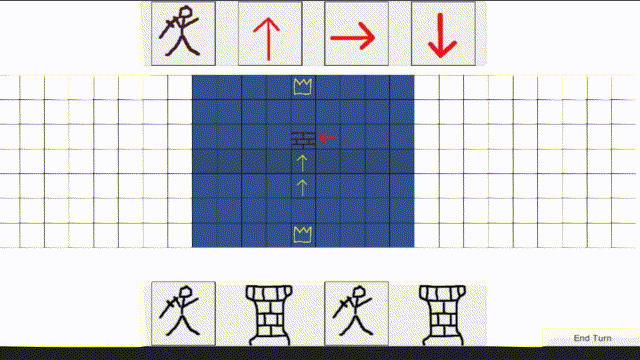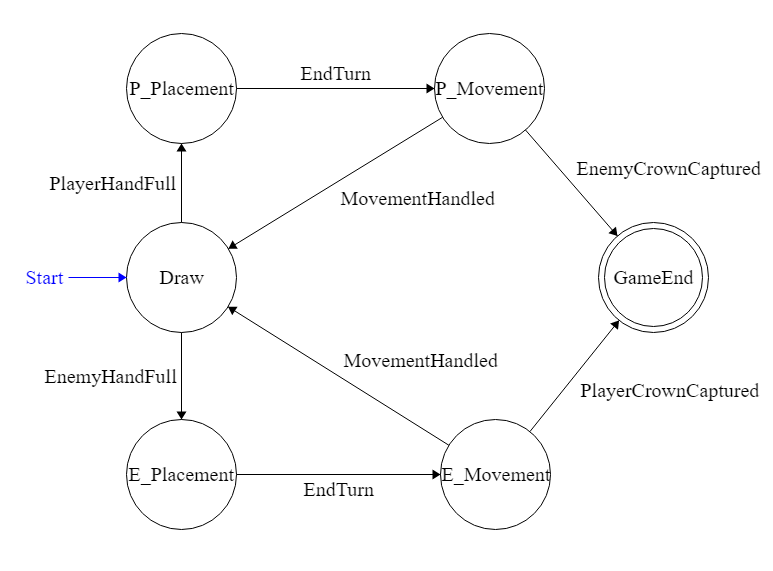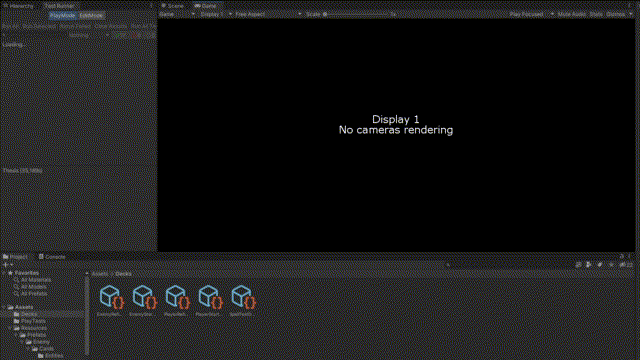Untitled Bachelor Project
This game is the practical part of Lena's bachelor thesis. My responsibility for this project lies in programming and implementing her ideas. I also use this opportunity of being the sole programmer for a bigger project to work on my expertise and coding skills. For that, I researched basic programming patterns and design principles to apply into the project. Furthermore, I started implementing Unity play tests to get a grip of test driven development processes. So far, we could create a playable prototype of the base gameplay loop.
The idea
This project is a turnbased deckbuilding strategy game, similiar to chess but as a deckbuilder. Players can build a deck from a set of tiles, each of which have their own functionality, such as tiles that move other tiles, or tiles that can attack or defend. The goal is to capture the enemy crown by colliding an attack tile with it. Players are able to see each others hands as to plan out their moves ahead. Tiles also break after using them too often or acquiring too much damage on a tile. The project is made with Unity.
The features
Controls
The game is controlled like a card game, meaning the player draws cards that resemble tiles and drag and drop them onto the playing field. Move-tiles can be placed anywhere, whereas defensive and offensive tiles can only be placed in a specific "placement zone". To save on resources, every time a tile is destroyed, it moves into the graveyard. Once all cards have been drawn, the graveyard is shuffled into the deck again. The graveyard serves as an object pool, meaning that rather than creating new instances, the old objects are reactivated to save on resources and performance.
//In CardObject class
[SerializeField]
private GameObject prefab
[SerializeField]
private Transform playerHand;
private int durability = 2;
public void Draw(CardObject obj) {
Card drawnCard = Instantiate(Resources.Load<GameObject>("Prefabs/UI/Card"), Vector2.zero);
drawnCard.transform.SetParent(playerHand);
drawnCard.Sprite = obj.Sprite;
}
public void PlayCard(Vector2 pos) {
GameObject cardObj = Instantiate(prefab, pos);
}
public void DecrementDurability() {
durability--;
if(durability <= 0) {
Kill(this);
}
}
public void Kill(CardObject obj) {
Graveyard.DeadCards.Add(obj);
obj.gameObject.SetActive(false);
}
public void Reincarnate(CardObject obj, Vector2 pos) {
obj.transform.position = pos;
obj.durability = 2;
obj.SetActive(true);
}
//In CardDeck class
public void DrawFromDeck() {
if(deck.Count > 0 && handSize < 4) {
CardObject drawnCard = deck.Dequeue();
drawnCard.Draw(drawnCard);
handSize++;
} else if (deck.Count == 0 && Graveyard.DeadCards.Count > 0) {
Shuffle(Graveyard.DeadCards);
DrawFromDeck();
}
}
private void Shuffle(List<CardObject> usedCards) {
Random shuffle = new Random();
var shuffledDeck = usedCards.OrderBy(item => shuffle.Next());
Graveyard.DeadCards.Clear();
foreach(CardObject card in shuffledDeck) {
deck.Enqueue(card);
}
}

The logic behind playing cards is fairly simple. The Card class is what is represented in the UI as cards on your hand. They have a draggable property and when dragged onto the playing field, the CardObject class' CreateInstance()-function is called. This summons a card object on the corresponding position. There is some collision handling in the backend to make sure that certain cards can't be put into certain places or on top of each other. Once placed on the field, card objects, or tiles, can interact with each other. Movement tiles move offensive tiles, whereas defensive tiles have other properties, like the wall repelling any offensive tiles back to it's position. Everytime a tile is used, durability is decremented. Offensive tiles get their durability only decremented when attacked by other attackers or towers.
Finite State Machine
For the implementation of the turnbased logic, I made a simple finite state machine with 6 states, Draw, PlayerPlacement, PlayerMovement, EnemyPlacement, EnemyMovement and GameEnd. Each state has it's own class implementing the IState interface. Here is the implementation of this state machine:
void Awake() {
//Collection of all states
var playerPlacement = new PlayerPlacementState(playerDeck);
var playerMovement = new PlayerMovementState();
var enemyPlacement = new EnemyPlacementState(enemyDeck);
var enemyMovement = new EnemyMovementState();
var draw = new DrawState(playerDeck, enemyDeck);
var gameEnd = new GameEndState();
//Transitions for each states added via AddTransition/At-function - first state is from, second state is to, third is condition
At(playerPlacement, playerMovement, EndTurn());
At(playerMovement, draw, MovementHandled());
At(draw, enemyPlacement, EnemyHandIsFull());
At(enemyPlacement, enemyMovement, EndTurn());
At(enemyMovement, draw MovementHandled());
At(draw, playerPlacement, PlayerHandIsFull());
At(playerMovement, endGame, EnemyCrownCaptured());
At(enemyMovement, endGame, PlayerCrownCaptured());
//Conditions for state change
Func<bool> EndTurn() => () => endTurn == true;
Func<bool> MovementHandled() => () => MovementManager.NoViableMoves == true;
Func<bool> PlayerHandIsFull() => () => playerDeck.handSize >= 4;
Func<bool> EnemyHandIsFull() => () => enemyDeck.handSize >= 4;
Func<bool> PlayerCrownCaptured() => () => playerCrown.IsAlive == false;
Func<bool> EnemyCrownCaptured() => () => enemyCrown.IsAlive == false;
}
public void EndTurnButtonOnClick() {
endTurn = true;
}
public void AddTransition(IState to, Func<bool> predicate) {
transitions.Add(new Transition(to, predicate));
}

Core functions like drawing or triggering movement to happen is called from the corresponding states. In return, most conditions are returned from the classes the state machine is calling, like movement or card decks. The shown implementation is slightly simplified but breaks it down pretty much to how it works. Transitions are added from a state to another, meaning a transition will only work out of the state it is set from towards the state that it is added to, and only if the condition is met. Finite State Machines are no novelty and a clean solution for statebased or turnbased games. A state diagram of the state machine can be seen on the left.

Unit Testing
For this project, I decided to research and implement elaborate unit tests to make testing, refining and refactoring features easier and improve workflow and code quality. For that, I wrote a number of tests for all core features and primary tile interaction. Running all current tests takes about 30 seconds and is fully automated. Tests are natively supported by Unity and can be run by the push of a button.
Postmortem
Being able to be the sole programmer for a larger project gives me a great deal of freedom to work on my own accords. Lena's directions and design decisions are of course the driving factor for development, but the amount of flexibility allowed me to use this project as a learning opportunity. I used this to deepen my understanding of the principles of test driven development, design- and programming patterns and the SOLID-principles. Of course, the project is still in the prototype stage. So it is expected that the learning process will continue further during development of the game.